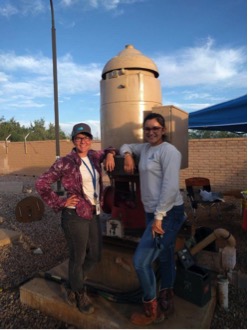Tiffani Cañez, a Hydrology & Water Resources student at the UA, is the recipient of the 2018 Leonard Halpenny Intern Scholarship.
I grew up in the Imperial Valley, CA, which — like Tucson — is a desert. From a young age, my parents, especially my father (a rancher from Sonora), taught me that water is essential to life in the desert. But in high school, I realized just how complicated water systems in the desert can be. When I came to the UA and started my degree, this concept was fortified. Furthermore, programs such as the Halpenny Internship give students like myself a unique opportunity to gain a very well-rounded experience of the type of work available for hydrologists. For my internship, I worked with Project WET, Tucson Water, Montgomery & Associates (M&A), and the USGS.

This brings me to the first week of my internship with Project WET. Most of my experience before this internship revolved around outreach to young students, so it was interesting to see what other outreach opportunities are available for teachers and students with respect to hydrology. As part of the internship, I took part of the annual STEM Teacher Academy, where numerous teachers from around the Tucson area were trained on water education activities that could be incorporated in their curricula to enable their students to be more water-conscious.
During my second rotation, I began my work with Tucson Water, where I was involved in departmental meetings and a lot of field work. First, I joined lead hydrologist of the recharge unit, Dick Thompson, to get a behind-the-scenes look at how directors’ meetings are run at Tucson Water. This was an interesting meeting that involved hearing updates from most of the departments that make up Tucson Water. I also got to meet most people from the Water Management and Planning Department and received a brief synopsis of what their work involves (thanks to Hector Zamora for taking me around the office and introducing me to everyone). My next experience at Tucson Water began with another meeting — this time with the field unit, which is led by hydrologist Molly Collins. After the meeting, I spent the rest of the day with Jerry Huerstel, who showed me most of the projects currently held by Tucson Water. We first met Beth Scully, who was in the process of fixing an automated water-level data logger at one of the monitoring wells for the new SHARP recharge project. We then went back into town, in which I experienced a “day-in-the-life” of Jerry. We went to two well sites within the city, where I got to retrieve pumping and recovery test data from a data logger. After that, we went out to another well site in the outskirts of the city, but this time the well was being prepared for a pumping test. The well was previously not in use, so it had to be brushed and bailed, which was something I had never done before and was so cool. And with that the workday-in-the-life of Jerry was over. I was also able to take a shift during the pumping and recovery test with Erin Gray who was an intern at the time. Working these two shifts was fairly simple and required measuring water levels in the well with a sounder and measuring water flows out of the well with a manometer. Additionally, I was able to experience the water quality sampling adventure with Jerry and Ricardo Garcia. They taught me how to set up the pump and record the samples in the computer as well as how to label the bottles. After collecting the samples, Ricardo and I went to Hayden-Udall water treatment plant, where these samples are processed. More recently, I went back to Tucson Water to work with Margaret Snyder. They recently got funded to provide maintenance for the CAVSARP basins. During this time, I learned about project management, in particular earned value management/analysis. This was useful to determine whether the project is on track to be completely within its budget and within the time of completion. I found this particularly interesting because it was not something I would typically expect a hydrologist to do. And with that my time at Tucson Water was complete.
After that, I began my time at M&A. Here I worked with Gary Woodard. I helped him and Mekha Pereira input data collected from their rainwater harvesting program into a spreadsheet. In addition, I was able to do a little bit of field work, which involved going out to the homes with these rainwater harvesting systems and fixing or replacing broken equipment such as data loggers and tipping buckets. I also helped Gary research information on how much water fruit and nut trees require to grow in Tucson for a project he is working on. For this I used some of the numbers I used working with the USGS.
Which brings me to my experience with the USGS, where I worked with the Water Use Program. I worked with Amy Reid and Ammon Cadogan doing field verification to confirm the types of crops farmers are growing so they can better estimate water uses in the basin determined by AWDR. In the Wilcox area, we saw a plethora of orchards and knowing that Gary needed information on their water use, I asked Amy for an estimate. I enjoyed being able to connect these two experiences because it helped me see how different organizations in the field of hydrology can help each other.
This was such a wonderfully enlightening experience and I would like to give a special thanks to Marla Odom for making this opportunity available. I would also like to thank Dr. Martha Whitaker and Samantha Pierce for writing me outstanding letters of recommendation for this internship.